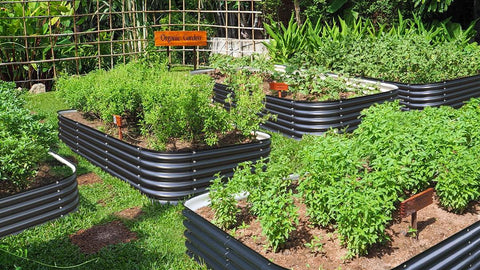Ripe for Success: Tips and Tricks for Raised Bed Fruit Gardening
Imagine stepping into your own garden and picking ripe, juicy fruits straight from the vine or tree. Raised bed fruit gardening makes this dream a reality, even for those with limited space or less-than-ideal soil. In this blog, we'll explore the joys of raised bed gardening fruit and provide you with valuable tips and tricks to ensure a fruitful harvest.
- Choose the Right Location
The first step to success in raised bed fruit gardening is choosing the right location for your beds:
- Sunlight: Most fruit-bearing plants require at least 6-8 hours of direct sunlight daily. Select a sunny spot in your garden.
- Proximity: Consider proximity to your home for easy access and watering. Raised beds can also be placed on patios or balconies.
- Optimal Bed Construction
Creating the right environment for your fruit-bearing plants is crucial:
- Bed Size: Build beds that are at least 12 inches deep for most fruits. Deeper beds are suitable for root vegetables, but 12–18 inches is ideal for fruit-bearing plants.
- Quality Soil: Fill your beds with well-draining, nutrient-rich soil. Mix compost and organic matter to enhance fertility.
- Spacing: Allow enough space between your beds for easy access and maintenance.

- Choose the Right Fruits
Selecting the right fruits for your raised beds is essential:
- Dwarf Varieties: Opt for dwarf or semi-dwarf fruit tree varieties that are more suited to confined spaces.
- Compatibility: Ensure that the fruits you choose are compatible in terms of sunlight, soil, and water requirements if you plan to plant multiple varieties of the same bed.
- Pruning and Training
Proper pruning and training techniques can maximize your fruit yield and save space:
- Espalier: Train fruit trees to grow flat against a wall or trellis using the espalier method. This saves space and increases sun exposure.
- Regular Pruning: Prune your fruit trees to remove dead or diseased branches and to maintain an open canopy for better air circulation and light penetration.
- Adequate Watering
Fruit plants need consistent moisture:
Drip Irrigation: Consider installing a drip irrigation system to provide consistent, deep watering while minimizing water waste.
- Mulch: Apply mulch around your plants to retain soil moisture and reduce weed competition.
- Pest and Disease Management
Keep a close eye on your fruit plants to protect them from pests and diseases:
- Companion Planting: Plant companion herbs and flowers to deter pests naturally. For example, basil can help repel aphids, and marigolds can deter nematodes.
- Organic Controls: Use organic pest control methods like neem oil or insecticidal soap to manage common fruit garden pests.

- Seasonal Care
Different fruits have different care requirements, so be attentive to the needs of your specific plants:
- Fertilization: Fertilize according to the needs of your fruit plants. Some may require a balanced fertilizer, while others might benefit from specific nutrient amendments.
- Winter Protection: In colder climates, consider winterizing your fruit plants with frost covers or wrapping trunks to prevent damage from freezing temperatures.
- Harvest at the Right Time
The moment you've been waiting for has arrived - harvesting your homegrown fruits:
- Timing: Harvest fruits when they are ripe but not overripe. Each fruit has its specific signs of ripeness; research and observation are key.
- Gentle Handling: Handle your fruits gently to avoid bruising. Use pruning shears or scissors for clean cuts
Raised bed fruit gardening is a delightful way to enjoy the fresh, delicious taste of homegrown fruits, no matter your gardening experience or available space. By selecting the right location, constructing suitable beds, choosing the best fruit varieties, and providing proper care, you can turn your raised beds into a bountiful orchard of delight. So, roll up your sleeves, get your hands in the soil, and get ready for a fruitful adventure in your own backyard.
